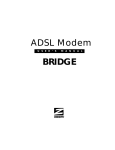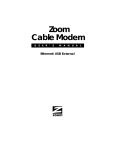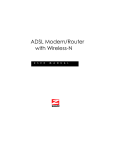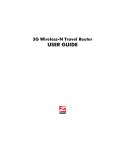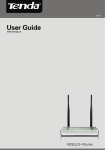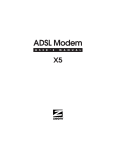Download Zoom 5754
Transcript
X5 U S E R M A N U A L NOTICE This document contains proprietary information protected by copyright, and this Manual and all the accompanying hardware, software, and documentation are copyrighted. No part of this document may be photocopied or reproduced by mechanical, electronic, or other means in any form. The manufacturer does not warrant that the hardware will work properly in all environments and applications, and makes no warranty or representation, either expressed or implied, with respect to the quality, performance, merchantability, or fitness for a particular purpose of the software or documentation. The manufacturer reserves the right to make changes to the hardware, software, and documentation without obligation to notify any person or organization of the revision or change. All brand and product names are the trademarks of their respective owners. © Copyright 2010 All rights reserved. Contents OVERVIEW ........................................................................................... 5 1. INSTALLATION INSTRUCTIONS ........................................................ 6 INSTALLING THE X5...................................................................................... 7 2. CONNECTING ADDITIONAL COMPUTERS AND/OR A NETWORK DEVICE ...............................................................................................15 3. ONLINE GAMING ............................................................................17 4. STATUS MONITORING ....................................................................19 WHY MONITOR STATUS? ............................................................................ 19 MONITORING ADSL STATUS ..................................................................... 19 5. ADVANCED SETUP OPTIONS...........................................................21 HOW TO USE THE ADVANCED OPTIONS................................................. 22 CHANGING YOUR WAN SETTINGS .......................................................... 24 CHANGING YOUR LAN SETTINGS ............................................................ 27 CONFIGURING FIXED DHCP MAPPING .................................................. 28 CREATING A VIRTUAL SERVER OR A DMZ.............................................. 29 DMZ.............................................................................................................. 31 PORT TRIGGERING ...................................................................................... 31 USING IP FILTERS ........................................................................................ 32 6. MANAGEMENT AND DIAGNOSTICS ................................................ 34 REMOTE ACCESS TO YOUR MODEM CONFIGURATION SETTINGS ....... 36 TR-069........................................................................................................... 36 CHANGING USER NAMES AND PASSWORDS ............................................ 37 BACKING UP YOUR CONFIGURATION ...................................................... 38 RESETTING DEFAULT SETTINGS ............................................................... 39 DIAGNOSTICS ............................................................................................... 40 APPENDIX A: ADSL INTERNET SETTINGS TABLES ...........................41 APPENDIX B: TOP AND BACK PANELS............................................... 47 APPENDIX C: TCP/IP NETWORK SETTINGS .................................... 48 APPENDIX D: TROUBLESHOOTING TIPS ........................................... 54 APPENDIX E: CONFIGURING YOUR WEB BROWSER ......................... 58 APPENDIX F: GETTING HELP ........................................................... 64 APPENDIX G: REGULATORY INFORMATION ..................................... 65 4 Overview The X5 integrates an ADSL modem, 4-port router, and firewall in one device. Each of the 4 Ethernet ports can be used for plugging in a computer, wireless access point, HomePlug adapter, or other network device. This User Manual contains installation instructions for direct connection of a Windows, Macintosh, or Linux computer. Once you’ve done a setup with one computer, you can use all 4 ports for connecting computers and other network devices. In addition to installation instructions, this manual has information about the X5’s advanced setup options. Most users will not need to use the advanced setup options, but these are useful for setting up security and various network parameters. Overview 5 1 Installation Instructions This chapter covers the basic instructions needed to connect your X5 to a computer and to the Internet. These instructions can be used for computers with a Windows, Macintosh, or Linux operating system. If you want to connect your X5 to a network device, you should first do the installation for a computer and then connect the network device. If you already installed and connnected your X5, you can skip this chapter and begin with Chapter 2. Package Contents Your package contains the following items: • • • • • Zoom X5 ADSL Modem Phone Cord Ethernet Cable Power Cube Software CD-ROM The CD contains the installation software, User Manual, and Customer Support information. If anything is missing or damaged, please contact Zoom Customer Support or whoever sold you the modem. In addition, the package may include: • Phone-jack adapter to adapt the phone cord to a particular phone jack (certain countries only) • ADSL line filter(s) (certain models only) 6 Before You Begin Before you begin installing the X5 modem using this manual, you must have the following available to you: • ADSL service enabled on your telephone line. To do this, you need to sign up with an ADSL service provider. Once this service is enabled, you should have an ADSL-enabled telephone wall jack to plug the X5 modem into. (Your service provider may refer to “ADSL service” as “DSL service.”) • A computer. The X5 supports the connection of a Windows, Macintosh, or Linux computer with an Ethernet port. • [Optional] Network device: You can connect the X5 to a network device such as a wireless access point or switching hub. If you plan to connect a network device, you should first do an installation with a computer connected directly to the X5. Once that’s working, you connect the X5 to the network device. Installing the X5 • To reduce the risk of fire, use the supplied phone cord. • Do not use this product near water — for example, in a wet basement or next to a swimming pool. If you are installing the X5 on a Windows computer go to Installing the X5 on a Windows Computer. If you are not using a windows computer, go to Installing the Computer on a Macintosh or Linux Computer. Installing the X5 on a Windows Computer 1 Turn on the Windows computer that you will use for setup. This can be any Windows 7, Vista™, XP, 2000, Me or 98 computer with an available Ethernet port. 7 2 Close any open programs, including any antivirus software or pop-up blockers. 3 Insert the supplied CD into the CD drive of your computer. The CD should start automatically. (If the CD does not start automatically, click the Windows Start button, click Run, and then type E:\setup.exe, where E is the letter of your CD drive.) Windows 7 or Vista: If the AutoPlay dialog box appears, click Run Setup.exe. If the User Account Control dialog box appears, click Allow. 4 Follow the on-screen prompts for the Install Assistant. Windows 7 or Vista: If a message tells you that Windows can't verify the publisher of the driver software, select Install this driver software anyway. If you are prompted to enter your ADSL provider user name and password, remember that these terms are case-sensitive. It will take 1-3 minutes to establish a connection with your ADSL service. Congratulations! Your installation is complete. Note: Windows 7 users may see a message box that says your software might not have installed correctly. You can safely ignore this message box. To install additional computers and/or devices to the X5, follow the instructions above and select the appropriate option in the Install Assistant. For Advanced Setup options and Troubleshooting Tips, please refer to the User Manual on the CD. Installing your X5 on a Macintosh or Linux computer Step 1: Connecting the Modem to a Computer 1 8 Place the X5 modem near the computer to be used for setup. 2 Connect one end of the supplied Ethernet cable to any of the computer’s Ethernet ports and the other end to your modem’s Ethernet (LAN) port. Back Panel Diagram DSL 3 ETHERNET 1 ETHERNET 2 ETHERNET 3 ETHERNET 4 RESET POWER SWITCH Connect the supplied phone cord between your modem’s DSL jack and a phone jack with ADSL service. Note: If you are using your ADSL modem on the same phone line where you’re also using other equipment such as telephones or fax machines, you should put an ADSL filter between each phone and the wall jack where the phone was connected. This filter prevents interference between the modem and the phone or other equipment. Your modem may have come with a filter, and filters are also available from retailers of phones, modems, and other electronics. The filter simply plugs into the wall telephone jack, and the female PHONE end of the filter connects to your telephone, fax machine, or other equipment. One form of filter is a splitter, which has one male plug and two female jacks. This lets you use the same phone jack for both an ADSL modem and a phone or other device. You plug the splitter into the phone jack, plug the modem into the jack that's typically marked ADSL, and plug the phone or other device into the jack marked PHONE. You may use the splitter as a filter; simply leave the ADSL jack open. 4 5 9 Plug the supplied power cube into the X5 modem, and then into a power outlet. Important: Use only the power cube shipped with your X5 modem. Other power cubes may damage the device. If the POWER LED does not light up, make sure the Switch button is pressed in. Turn on the computer. The ETHERNET LED on your modem’s top panel corresponding to the Ethernet port your device is plugged into should turn on. After a few seconds, your DSL LED will begin blinking, then become solid. If it does not become solid, please refer to Appendix D: Troubleshooting Tips on page 54. Step 2: Establishing Communication Important! Mac users must make sure that the computer’s TCP/IP settings are configured properly BEFORE starting this section. See Macintosh TCP/IP Settings. 1 2 Open your computer’s Web browser, enter 192.168.1.1 in the address bar, and press the Enter key. In the Authentication Required dialog box, type the following User Name and Password in lower case, then click OK. User Name: admin Password: zoomadsl (For easy future reference, the above information is printed on the bottom of your X5 unit’s case.) 3 4 5 6 10 The Zoom Configuration Manager opens and displays its Basic Setup page. You may choose to use either the Automatic Configuration option or manually enter information provided by your service provider in the Basic Setup page. We recommend using the Automatic Configuration option. (If you are using a static IP address, you must manually enter information to establish communication.) If you choose to manually enter information, please go to the next section (Read This Only if Your Are Manually Entering Information Into the Basic Setup Page). If you would like to use the Automatic Configuration option, please go to step 5 below. Click on Start under Automatic Configuration. It may take up to 2-3 minutes to detect your connection. If a PPPoE or PPPoA connection is detected, enter the username and password provided by your service provider for PPPoE or PPPoA protocols. (Your provider should have given you a User ID or User Name, usually your email address or the characters preceding the @ sign in your email 7 address, and a Password. These are NOT the User ID and Password that you used to get into the Basic Setup menu.) Click Next three times to reach the Summary Page of the setup. If a 1483 Bridged IP+NAT or 1483 Routed IP connection is detected, click Next until you reach the Summary Page of the setup. On the Summary Page, click Save/Reboot. Congratulations! If you want to connect your X5 to only one computer, you are now done. Your modem is connected. To test your installation, open your browser and go to a familiar Web site. If your browser works, installation is complete for the computer you used for setup. If your browser doesn't work, please refer to Appendix D: Troubleshooting Tips on page 54. Read This Only if You Are Manually Entering Information Into the Basic Setup Page If your service provider gave you Protocol, VPI, VCI, and Encapsulation settings and you are choosing to manually enter information into the Basic Setup page, do the following: a Leave the PVC box at PVC0. b If you have this information (Protocol, Encapsulation, VPI, and VCI), select the correct Protocol from the list. If you were not given this information, please refer to the ADSL Internet Settings Tables at the end of this Quick Start to find Protocol, Encapsulation, VPI, and VCI information for your provider / country. c Enter the Encapsulation, VPI, and VCI in the appropriate boxes. d If you selected PPPoE or PPPoA as your Protocol, your provider should have given you a User ID or User Name (usually your email address or the characters preceding the @ sign in your email address) and a Password. (These are 11 NOT the User ID and Password that you used to get into the Basic Setup menu.) If you cannot remember or cannot find your User ID and Password, call your service provider and ask for them. Then enter them in the appropriate boxes. This information is required for PPPoE and PPPoA protocols. e If you selected 1483 Bridged IP+NAT or 1483 Routed IP as your Protocol, your provider should have given you four series of numbers for the IP (Internet Protocol) Address, Subnet Mask, Gateway, and DNS. Enter these numbers in the appropriate boxes, and select Use the Following IP Address. f Click Save/Reboot. g Your modem should now be properly connected. To test your installation, open your browser and go to a familiar Web site. If your browser works, installation is complete for the computer you used for setup. In that case continue at If Your Browser Works below. If your browser doesn't work, please refer to the section If Your Browser Doesn’t Work below. Click X to close the window. Your basic setup is complete! The options that are set in the Basic Setup page are sufficient for most users. However, those who want or need to change the modem’s settings can do so using the Advanced Setup page. If your Browser Works Please consider these things: A) Are you using your ADSL modem on the same phone line where you’re also using other equipment such as telephones or 12 fax machines? If not, continue with B below. If you ARE, on the other hand, you should put an ADSL filter between each phone and the wall jack where the phone was connected. This filter prevents interference between the modem and the phone or other equipment. Your modem may have come with a filter, and filters are also available from retailers of phones, modems, and other electronics. The filter simply plugs into the wall telephone jack, and the female PHONE end of the filter connects to your telephone, fax machine, or other equipment. Phone Filter Wall telephone jack One form of filter is a splitter, which has one male plug and two female jacks. This lets you use the same phone jack for both an ADSL modem and a phone or other device. You plug the splitter into the phone jack, plug the modem into the jack that's typically marked ADSL, and plug the phone or other device into the jack marked PHONE. You may use the splitter as a filter; simply leave the ADSL jack open. B) If you want to use your modem for more than one computer, you will want to attach the modem to a wireless access point, switching hub, or other appropriate network device. In that case, please go to Chapter 2 now. If you only want to use your modem with one computer, please go to Chapter 3 now. If Your Browser Doesn’t Work Repeat steps c-g above and make sure that you enter the information correctly (especially your Username and Password, if 13 your Encapsulation begins with PPP). If you still cannot connect, look up your provider in the ADSL Internet Settings Tables in Appendix A and try the setting(s) shown, if different. If you did not connect and were using settings from the ADSL Internet Settings Tables, return to the tables and find the next most frequently used settings—those labeled (2) if you just entered (1), or (3) if you just entered (2), and repeat steps c-g above. If this doesn’t work, please see Appendix D: Troubleshooting Tips on page 54. 14 2 Connecting Additional Computers and/or a Network Device If you want to connect your X5 to only one computer, please go to Chapter 3 now. If you want to connect the X5 to additional computers or to a network device such as a wireless access point or a switching hub, please continue reading Chapter 2 below. This section provides general instructions for connecting the X5 to additional computers, game stations, Homeplug adapter pairs, network devices such as a wireless access point or a switching hub, or a combination of the above. For information about setting up your specific device, please refer to the documentation that came with that device. Follow the instructions below for each computer or other device. 1 2 3 15 In setting up the X5, you connected the X5 to a computer. Unplug the computer now if you don’t want it to stay connected to the X5. Plug one end of an Ethernet cable into an available Ethernet port on the X5 and plug the other end of the Ethernet cable into the Ethernet port of the additional device you want to connect to the X5. (For a hub or a switch, this is typically called an Uplink or Expansion port. For a router or wireless access point, this is typically called a WAN port.) If you are connecting a computer or game station, go to step 5 below. If you are connecting a Homeplug adapter pair with one adapter plugged into the X5 and an AC outlet, and the other adapter plugged into a computer or game station and an AC outlet, make those connections and then go to step 5. If you are connecting a network device such as a wireless access point or switching hub, go to step 4 below. 4 5 Set up your network device by using the instructions that came with that device. Then reboot any computer that is part of your network. For example, if you connected a wireless access point, reboot any computer that will make a wireless connection to that wireless access point. Verify that your Internet connection is working. Open the Web browser (e.g., Internet Explorer or Mozilla Firefox) on each computer or other device using your network and try to connect to a familiar Web address. Note: If at any time you need to make changes to the ADSL modem configuration, open a web browser from any PC on your ADSL modem’s network and type 192.168.1.1 to open the modem’s Setup pages. Alternately, you can connect a computer directly to the X5, open its browser, and then type 192.168.1.1. Note also that you can configure the Management section of the X5 Setup pages to permit configuration from a remote location. Congratulations! You have connected an additional device to the Internet. You can connect up to 4 devices to the X5, following the instructions above for each device and starting at Step 2. When you are finished, your setup may be complete. Please check the Contents on page 3 to see whether there’s anything relevant to you in chapters 3, 4, 5, 6, or the Appendix. If not, you should be all set to enjoy your X5. 16 3 Online Gaming If you are using your router for gaming, you may need to make changes to the router’s firewall setting for the game to work. This is done by setting up a DMZ or virtual server, or using port triggering so that the modem’s firewall won’t block the other players from your system during your gaming. The main difference between the three methods is the amount of access someone has to your system. A virtual server will allow access to your computer or gaming station on certain ports. A port is a channel that is used by applications (such as games) for communication. For example, the directions for the game you want to play over the Internet might tell you to open up port 6000. Port triggering works by sensing when data is sent out on the predetermined outgoing port and then automatically opening up the corresponding incoming port(s). It will automatically forward the traffic on the incoming port to the computer that accessed the outgoing port. If your game uses one port to send outgoing data and a different port (or ports) for incoming data, you may want to use port triggering. The advantage of port triggering is that it is more secure than setting up a virtual server since the incoming port is only open when you are using it, and since it tracks which computer sent the outgoing data. Port triggering can also be easier to set up because you do not need to know the IP address of your gaming station. The disadvantage of port triggering is that only 1 host can be accessing the port at one time, so if you have two computers or game stations playing the same game on your network you will need to use a virtual server or DMZ. A DMZ differs from a virtual server in that it allows access on all ports of the computer. Because of this, DMZ's are less secure and 17 should be used with caution on your computer. However DMZ’s work well with your gaming stations since security is not as much of an issue for gaming stations as it is for computers. Once you’ve decided what type of security to use for gaming, you can set up that security using the appropriate section of this manual: 18 • Virtual Server: For instructions on how to set up a virtual server, please refer to page 30. • Port Triggering: For instructions on how to set up port triggering, please refer to page 31. • DMZ: For instructions on how to set up a DMZ, please refer to page 31. 4 Status Monitoring This chapter discusses how to check the status of your modem and its ADSL connection. Most users can skip this chapter, as it is primarily for advanced users and for those who are instructed by their Internet service provider or Zoom Technical Support to verify settings, usually for troubleshooting. If you skip this section, you should go to Chapter 5. Why Monitor Status? The X5 provides easy-to-read screens for you to review the status of the modem and its ADSL connection. While most users will probably never need to check the status, there are some cases in which it would be helpful. For example, you may need to know the IP address assigned to you by your Internet service provider. For advanced users with special configuration needs, the status information is useful for overall system maintenance. Monitoring ADSL Status If you want to check the status of your ADSL connection, click on the Status link on the left pane in the Zoom Configuration Manager. (If you forgot how to log in to the Zoom Configuration Manager, see page 10.) The Status page provides information about your ADSL connection. For example, you can verify whether your ADSL 19 connection is active or not. You can also monitor related ADSL parameters—for example, how fast the X5 is transferring data (Downstream Speed and Upstream Speed), your WAN settings, your LAN settings, and so forth. Note: The Status page does not provide a way to change any of these settings—see Chapter 5: Advanced Setup Options, if you need to make changes to these settings. 20 5 Advanced Setup Options The options that are set by default when the X5 is installed are sufficient for most users. However, those that want or need to change the X5’s settings can do so using the Advanced Setup page. This chapter explains how to specify advanced options. The information in this chapter applies to you if: • Your Internet service provider instructs you to enable, disable, or change the default settings for your X5 in order for it to work properly with your ADSL service. See How To Use the Advanced Options on page 22 for a table listing the Advanced Setup areas that you can customize. • You need to change your Wide Area Network settings. See Changing Your WAN Settings on page 24 for more information. • You want to add a virtual server, DMZ, or set up port triggering for use with an online game. See page 29. • You want to add, remove, or change the IP Filters. See Using IP Filters on page 32 for more information. If none of these items applies to you, you should continue with Chapter 6: Management and Diagnostics. Chapter 5: Advanced Setup Options 21 How To Use the Advanced Options Configuring the X5 for the situations described at the beginning of this chapter requires the use of the Advanced Setup page. To access this page, click on the Advanced Setup link on the left pane in the Zoom Configuration Manager. (If you forgot how to log in to the Zoom Configuration Manager, see page 10). Advanced Setup Options Use the links on the left pane in the Zoom Configuration Manager under Advanced Setup Options to perform advanced configuration tasks. The following table lists each option under Advanced Setup and gives a brief description of the settings you can specify. Open page from… This button… Opens a page that lets you… Advanced Setup WAN Specify how your Wide Area Network ADSL setup is configured. Advanced Setup LAN Configure LAN IP Address, LAN DHCP Server Pool, Fixed DHCP Mapping, set up a second LAN IP Address, and IGMP Snooping. Advanced Setup NAT Configure Virtual Servers (Port Forwarding), Port Triggering, and a DMZ. Advanced Setup Security Set up rules to control the forwarding of incoming and outgoing data between your LAN and the Internet and within your LAN. For example, you can create IP filter rules to block attempts by certain computers on your LAN to access certain types of data or Internet locations. You can also block or allow incoming access to computers on your LAN. This page displays the current filters and lets you edit and add filters. Advanced Parental 22 (IP Filtering) Allows for URL filters to be set up. Setup Control Advanced Setup Quality of Service (Queue Management Configuration) Allows different priorities to be assigned to different applications, users, data, or guarantee a certain level of performance to data (for upstream only, not for downstream). If Enable QoS checkbox is selected, choose a default DSCP mark to automatically mark incoming traffic without reference to a particular classifier. Advanced Setup Routing Set up the routes on which you want the X5 to send data it receives on a particular interface (for example, LAN interface, Ethernet interface, etc.) Routes specify the IP address of the next device interface or Internet destination to forward data to, given the ultimate destination of the data. Advanced SetupÆ DNS DNS Server Allows you to Enable Automatic Assigned DNS. The modem will accept the first received DNS assignment from one of the PPPoA, PPPoE or 1483 Bridged IP + NAT enabled PVC(s) during the connection establishment. If the ‘Enable Automatic Assigned DNS’ checkbox is not selected, enter the primary and optional secondary DNS server IP addresses. Advanced SetupÆ DNS Dynamic DNS Allows you to alias a dynamic IP address to a static hostname in any of the many domains, allowing your DSL router to be more easily accessed from various locations on the Internet. If you are running a web server on your network and do not have Static IP address from your service provider you can sign up with a dynamic DNS provider to ensure the URL of your website is correctly forwarded to your IP address. Chapter 5: Advanced Setup Options 23 Advanced Setup DSL Allows you to select the modulation and capability of DSL Settings. Advanced Setup Interface Group This proxy enables the router to send all multicast/unicast traffic to a specific upstream interface. Most users will not use this feature, it is typically used for IPTV applications. Changing Your WAN Settings Use the WAN Configuration page to change your Wide Area Network (WAN) settings. To open this page, click the WAN link under Advanced Setup on the left pane. To Edit a Previous Configuration: If you already created a configuration (from the Basic Setup page or from the WAN page at an earlier time), you can click Edit to make changes to that configuration. Then use the Next and Back buttons to navigate through a series of pages where you can make changes to advanced parameters such as the ATM Traffic Class and Encapsulation Mode, and enabling NAT settings, IGMP Multicast, and WAN Service. To Add a New Configuration: If you want to add a new configuration from this page, start by clicking Add. Then use the Next and Back buttons to navigate through a series of pages where you can make changes to advanced parameters such as the ATM Traffic Class and Encapsulation Mode, and enabling NAT settings, IGMP Multicast, and WAN Service. Once you have made the changes you want on the first section, click on Next to proceed to the following section. Repeat this until you reach the WAN Setup – Summary page. Then click the Save/Reboot button. 24 The following table describes the settings on the WAN Configuration pages and the values that you can enter. The settings displayed on the page will vary according to the protocol you are using. Setting Description PVC Displays the value (PVC0 through PVC3) of the selected Permanent Virtual Circuit (PVC). You can set the PVC value by entering it in the text box. VPI Virtual Path Identifier ranges from 0 – 256. Your DSL provider supplies the VPI when you sign up for ADSL service. VCI Virtual Circuit Identifier ranges from 0 – 65536. Your DSL provider supplies the VCI when you sign up for ADSL service. ATM Traffic Class These settings allow you to give priority to data that is sent over the network. Important! You must make arrangements with your DSL provider to use anything except UBR (Unspecified Bit Rate) in the Traffic Class setting. Your service provider will also supply you with the Cell, Burst, and Tolerance Rates. Connection Type Your Internet Service Provider supplies this value. If your service provider instructs you to use 1483 Bridged mode, select 1483 Bridged + NAT to take advantage of your modem’s advanced routing and firewall features. Encapsulation Mode The encapsulation value should match your DSL provider’s encapsulation. The Chapter 5: Advanced Setup Options 25 value refers to the way that data is passed over the Internet. An example value is LLC (Logical Link Control). Your DSL provider supplies this value when you sign up for ADSL service. Username Your DSL provider supplies this PPP username when you sign up for ADSL service. Password Your DSL provider supplies this PPP password when you sign up for ADSL service. MTU Maximum Transmission Unit. Largest physical packet size, measured in bytes, that the modem can send. Any messages larger than the MTU have to be fragmented before being sent. NAT Network Address Translation. By default, this setting is Enabled. NAT keeps a table of individual private IP addresses in your network and refers to the table when incoming requests are made. If no matches are found, the incoming data cannot come into your network. An Enabled setting keeps your IP addresses hidden from outside users. Service Name This is an optional value that your service provider may ask you to enter. After you enter your values, click Save/Reboot. 26 Changing Your LAN Settings When would I need to change my LAN settings? DHCP (Dynamic Host Configuration Protocol) is a protocol that enables your modem to manage the assignment of IP addresses to computers and devices on your Ethernet (LAN) network on the X5. Enabling DHCP on your modem allows it to assign temporary IP addresses to your computers whenever they connect to your network. You can control the amount of time that elapses before a new address is issued or renewed. You can extend the range of IP addresses that are assigned to your network devices should you add new devices to your network. You can also change the default LAN IP address for your modem. The following table shows you the values to enter. After you enter the values, click Save/Reboot. Setting Description IP Address The LAN IP address of your modem. This is the IP Address at which PCs and other devices in your network will contact your modem.* Subnet Mask The modem's subnet mask address. Enable/Disable DHCP Server By default DHCP Server is enabled; this allows the X5 to assign IP addresses to the devices connected to your X5. If you wish to use static IP addresses on your network disable the DHCP server. When DHCP Server is enabled you will need to enter the Start IP Address, End IP address, Subnet Mask, and Lease Time for your network. Start IP Address The first IP address of a range that you specify using the Start and End IP Chapter 5: Advanced Setup Options 27 Address settings. Your modem's DHCP server will assign the IP addresses in this range at random to the computers and devices in your network. Note that the Start and End IP Addresses must both be in the same subnet as the IP Address, above. End IP Address The last IP address of a range that you specify using the Start and End IP Address settings. Your modem’s DHCP server will assign numbers from this range at random to the computers and devices in your network. By default the DHCP server has 253 addresses available to assign. If you plan on attaching more than 253 devices to your network, change the ending IP address to allow for more devices. Note that the Start and End IP Addresses must both be in the same subnet as the IP Address, above. Subnet Mask This is the subnet mask for your network. Leased Time (hour) The maximum amount of time, in hours, that a network device will have the temporary IP address before a new one is issued by the modem’s DHCP server. Configuring Fixed DHCP Mapping Fixed DHCP mapping is used when you want the modem to always assign the same IP address to a computer or gaming device. You would want to do this if you were setting up a virtual server or DMZ using this device. 28 To set up a device with Fixed DHCP Mapping: 1 Click Advanced SetupÆ LAN to open the LAN page. 2 Under Fixed IP Mapping click on Add Entries. 3 Enter the MAC Address of the computer or gaming station that you wish to assign a fixed IP address to. Tip: To find the MAC address of your device go to STATUSÆ DHCP. This page shows you a list of all devices connected to your router as well as their MAC addresses. 4 Enter the IP address that you always want assigned to your computer or gaming station. This address can be the one already given to it on the DHCP Status page or can be an unused IP address. For example if none of the devices on the DHCP Status page have been assigned 192.168.1.25 you can use that as the IP address. 5 Click Save/Apply to store your settings. Creating a Virtual Server or a DMZ Do I need to create a virtual server or DMZ? By default, your modem uses NAT to hide your computers from users on the Internet; however, there may be times when you want to allow access by outside users to a computer or gaming station on your network. For instance, you would want to allow access if a computer in your network is hosting Internet games or running a web server. If you wish to set up your X5 for online gaming you should refer to Chapter 3: Online Gaming to help you decide if a Virtual Server, DMZ or Port Triggering is right for you. Chapter 5: Advanced Setup Options 29 To create a Virtual server: 1 Click Advanced SetupÆ NATÆ Virtual ServersÆ Add to open the Add Virtual Servers page. 2 For the server name check the list of predefined games and applications to see if yours is on the list. If it is, go ahead and select it. You will need to enter the IP address of your computer or gaming station in the Server IP Address field but the rest of the information will be filled out for you. 3 Click Save/Apply to save your new virtual server. 4 If your game or application was not on the list continue to step 5 to create a custom Virtual Server. 5 Enter a Custom Server name for your virtual server. 6 Enter the IP address on the computer or game station that you want to use the virtual server with in the Server IP Address field. 7 You should set up a fixed DHCP address for that device to prevent the IP address from changing in the future 8 For each range of ports you need to open up enter the Starting and Ending External Ports and the Protocol used. Your game documentation should provide you with this information. 9 If you only need to open one port, enter that port number in both the Start and End External Port fields. 10 Once you enter the External Ports, the Internal Port fields will automatically be set to the same values. The Internal ports cannot be changed. 11 If you know the Remote IP address of the device you are connecting to, enter it under the Remote IP field. If you don’t know it you can leave this field blank. 12 Click Save/Apply to save your new virtual server. 30 DMZ Use this page to designate a computer or gaming station on the Local Area Network as a DMZ (Demilitarized Zone). When you set up a DMZ, all ports on that computer are opened up to all Internet traffic – the computer is no longer protected by the X5’s NAT firewall. Caution should be used when setting up a computer with a DMZ. A game station does not have the same security issues as your computer so setting up a DMZ works well with your game station. You may want to create a DMZ if a computer in your network is acting as a web server or hosting Internet games. You need to manually assign an IP address to the DMZ. DMZ Host IP Address: Enter the IP address of the computer or gaming station designated as a DMZ. Note: You need to give your LAN PC clients a fixed/static IP address for DMZ to work properly. Click Save/Apply. Port Triggering Port triggering allows a host machine to dynamically forward a specific port back to itself and is a way to automate port forwarding. When traffic is seen on an outgoing port any traffic received on the corresponding incoming port will be forwarded to your computer or gaming station. To set up port triggering, follow the instructions below. 1 Click Advanced SetupÆ NATÆ Port Triggering. 2 Click Add to add a new Port Triggering rule. 3 Check the drop down list next to Server Name (check that this is called server name). If your game or application is listed, go ahead and select it. 4 Click Save/Apply. Chapter 5: Advanced Setup Options 31 If your game or application is not listed, enter a Custom Name for your port triggering rule and go to step 5. 5 Enter the Start and End Trigger Ports in the text fields. Your games documentation should supply you with this information. 6 Select the Protocol for the Trigger Protocol from the dropdown menu. 7 Enter the Start and End Open Ports in the text fields. 8 Select the Open Protocol from the drop-down menu. 9 Repeat steps 5-8 for each range of ports you want to trigger open ports with. When you are finished go to step 10. 10 Click Save/Apply. Note: To delete a previously created Trigger Port, click the checkbox of the Trigger Port in the Trigger Port list and click Delete. Then click Apply to save your settings. Using IP Filters Use the IP Filter Configuration page to set up IP filters to block outgoing or allow incoming traffic into your computer from the Internet. To open this page, click Advanced Setup Æ Security. Then click on IP Filtering. Select Outgoing or Incoming depending on which type of filter you want to set up. Outgoing IP Filtering Setup: By default, all outgoing IP traffic from LAN is allowed, but some IP traffic can be blocked by setting up filters. Choose Add or Remove to configure outgoing IP filters. Once you have set up the IP filters you want, click the Save/Apply button. Incoming IP Filtering Setup: By default, all incoming IP traffic from the WAN is blocked when the firewall is enabled. However, some IP traffic can be accepted by setting up filters. 32 To filter Internet traffic, you must define one or more rules (that is, criteria you want the information to meet before it can proceed). As information comes in from the Internet, the X5 examines it and—if it meets the rule—the information moves forward to its destination on your computer or network. If it does not, it is discarded. The rule can be based on many characteristics, including the network or Internet protocol it carries, the source IP address, the port that the traffic is coming in on, and so forth. Choose Add or Remove to configure incoming IP filters. Once you have set up the IP filters you want, click the Save/Apply button. Chapter 5: Advanced Setup Options 33 6 Management and Diagnostics Please read this chapter if you want to perform modem management functions, as discussed below, or if you want to run diagnostics to diagnose a modem problem. If you don’t want to do either of these things, your modem is probably set up and ready to go. You may want to read Appendix B: Top and Back Panels, for details about the modem’s lights and back panel jacks. Management Buttons The buttons in the Management group are typically used for administrative tasks, such as upgrading firmware, changing your Zoom Configuration Manager password, etc. The following table lists each button in the Management group and gives a brief description of the settings you can specify. Open page from… ManagementÆ Settings Management This button… Opens a page that lets you… Backup Save your current configuration settings to a file so that they may be restored at a later time. Update Upload your previously saved settings. Restore Default Restore the X5 settings to the factory defaults. System Log By default the System Log is disabled. You must Enable it and then click View System Log. View data generated or acquired by routine system communication with other devices. This information does not necessarily represent unexpected or 34 improper functioning and is not captured by the system traps that create alarms. You can save the system log to a file. Management TR-069 Client Allow an Auto-Configuration Server (ACS) to perform auto-configuration, provision, collection, and diagnostics to the ADSL modem. Select the desired values and click Save to configure the TR-069 client options. ManagementÆ Access Control Services A Service Control List (“SCL”) enables or disables router services (for LAN / WAN such as FTP, HTTP, ICMP, and TELNET) from being used. ManagementÆ Access Control IP Addresses The IP Address Access Control mode, if enabled, permits access to local management services from IP address contained in the Access Control List. This mode is disabled by default. ManagementÆ Access Control Passwords Manage the User IDs and passwords that can access the Zoom Configuration Manager. This is where you can change the default password supplied to you with the X5. Management Update Software Specify the path to the upgrade file you need to update your firmware. Use the Browse button on this page to navigate to the file, then click the Update Software button to perform the firmware update. Management Save / Reboot Click the Save / Reboot button on the Save / Reboot page to reboot the modem. Chapter 6: Management and Diagnostics 35 Remote Access to Your Modem Configuration Settings If you want to access your modem configuration manager to change or view your configuration settings remotely: 1 2 3 4 5 Click on Management. Click on Access Control, and then select the enable check box for Http WAN to allow access from a remote PC. Click Save/Apply and wait several seconds for the settings to be saved. Click on Status from the left pane of the Zoom Configuration Manager. Click on WAN. Write down the public IP address displayed under WAN Info. Type this public IP address into the browser of your remote PC. At the log in prompt, enter the user name and password shown below: User name: support Password: support You can now view or make changes to your modem’s configuration from your remote PC. TR-069 The TR-069 option opens the Configuration page, where you can allow an Access Control Server (ACS) to control and configure your X5. CWM stands for the CPE WAN Management protocol. This feature must be supported by your service provider and should be used only if the provider instructs you to enable it. After you make changes on the Configuration page, click Save. 36 Changing User Names and Passwords Use the Passwords page to manage the user names and passwords that can access the Zoom Configuration Manager. To open this page, click on Advanced Setup Æ Management Æ Access Control Æ Passwords. When you installed the X5 and tried to open the Zoom Configuration Manager, you were prompted for a User Name and Password in order to gain access. (The default user name and password were supplied to you in the section Establishing Communication.) If you want, you can change the default password. Changing the password is not required, but as a good security measure, we recommend it. To change the default password Access to your DSL modem is controlled through three user accounts: admin, support, and user. 1 2 3 Select the User name for which you want to change the password from the drop-down menu. Enter the current password in the textbox Old password. Choose the password you would like to replace it with (up to 16 characters without any spaces) and enter it in the textbox New password. 4 Retype the password in the textbox Confirm password. 5 Click on Save/Apply. Chapter 6: Management and Diagnostics 37 Backing Up Your Configuration Users who change the configuration settings for the X5 may want to back up their settings. This will enable them to restore those settings at a later time, if needed. This feature may be especially useful when you receive firmware updates from Zoom. Installing the update may overwrite your customized settings with default values. Before you update the firmware, backup your configuration. Then, after the firmware has been updated, restore your configuration. Note: You do not need to back up the default settings. This is because you can easily restore the defaults by clicking on Advanced Setup on the left pane of the window, then Management Æ Settings Æ Restore Default. For more information, see Resetting Default Settings on page 39. To back up your current configuration Use the Backup page to save your modem’s current configuration to a file on your computer. 1 2 3 38 Click on the Management link on the left pane of the window. Then click on the Settings link. Then click on the Backup link. On the Backup page, click Backup Settings to download a configuration file from the X5 to a folder on your computer. Be sure to note the name (backupsettings.conf) and location. You will need this information if you ever want to restore the X5 to this backed-up configuration. (You can change the name of the file and specify a location for it on your computer after it is downloaded.) To restore a configuration 1 Click on the Management link on the left pane of the window. 2 Then click on the Settings link. 3 Then click on the Update link. 4 5 On the Update Settings page, click Browse and navigate to the file containing the configuration to which you want the X5 restored. Click Update Settings. Resetting Default Settings If you have changed the system settings on your X5 and for some reason want to restore them to the factory default settings, you can do so in one of two ways: You can perform a software reset or a hard reset. To reset using the X5’s Web interface If you can open your Web browser and access your X5’s user interface, do the following to perform a software reset: 1 2 3 Log into the Zoom Configuration Manager. (See page 10 if you need help logging in.) Click on the Management link on the left pane of the window. Then click on the Settings link. Then click on the Restore Default link. Click the Restore Default Settings button. To perform a hard reset If you lose your link to the unit and cannot communicate with it via the Web browser, do the following to perform a hard reset: Chapter 6: Management and Diagnostics 39 Insert a paper clip into the RESET pinhole in the center of the modem’s back panel and hold it there for five seconds. You are now guaranteed that all system settings are restored to the X5’s factory defaults. Diagnostics You can use the Diagnostics page to run a series of diagnostic tests of your system software and hardware connections. 40 Appendix A: ADSL Internet Settings Tables These tables are for customers whose service providers do not supply them with the ADSL settings to connect to the Internet. Many ADSL providers use different settings depending on the region in which they are operating, which is why there may be more than one setting for your service provider. We post updated tables on our Web site. If your country is not listed in the tables below, please consult www.zoomtel.com Note to USA customers If your ADSL service provider is not shown below, first use the settings for Service Provider Not Shown at the bottom of the table. If those settings do not work, use the settings for the company that provides local telephone service in your area. Table A: USA ISP VPI VCI Encapsulation All Tel (1) 0 35 PPPoE LLC All Tel (2) 0 35 1483 Bridged IP LLC AT&T (1) 0 35 PPPoE LLC AT&T (2) 8 35 1483 Bridged IP LLC AT&T (3) 0 35 1483 Bridged IP LLC August.net (1) 8 35 1483 Bridged IP LLC August.net (2) 0 35 1483 Bridged IP LLC BellSouth 8 35 PPPoE LLC Castle.Net 0 96 1483 Bridged IP LLC CenturyTel (1) 8 35 PPPoE LLC CenturyTel (2) 8 35 1483 Bridged IP LLC Coqui.net 0 35 PPPoA LLC Appendix A: ADSL Internet Settings Tables 41 Covad 0 35 PPPoE LLC Crocker Communications 0 35 PPPoE LLC Earthlink (1) 0 35 PPPoE LLC Earthlink (2) 8 35 PPPoE LLC Earthlink (3) 8 35 PPPoE VC-MUX Earthlink (4) 0 32 PPPoA LLC Eastex 0 100 PPPoA LLC Embarq 8 35 1483 Bridged IP LLC 4DV.net 0 32 PPPoA VC-MUX Frontier 0 35 PPPoE LLC Grande Communications 1 34 PPPoE LLC GWI 0 35 1483 Bridged IP LLC Hotwire 0 35 1483 Bridged IP LLC Internet Junction 0 35 1483 Bridged IP LLC PVT 0 35 1483 Bridged IP LLC Qwest (1) 0 32 PPPoA VC-MUX Qwest (2) 0 32 PPPoA LLC Qwest (3) 0 32 PPPoE LLC Qwest (4) 0 32 1483 Bridged IP LLC SBC (1) 0 35 PPPoE LLC SBC (2) 0 35 1483 Bridged IP LLC SBC (3) 8 35 1483 Bridged IP LLC Socket (1) 8 35 1483 Bridged IP LLC Socket (2) 0 35 1483 Bridged IP LLC Socket (3) 0 35 PPPoE LLC Sonic 0 35 1483 Bridged IP LLC 42 SouthWestern Bell 0 35 1483 Bridged IP LLC Sprint (1) 0 35 PPPoA LLC Sprint (2) 8 35 PPPoE LLC SureWest Communications (1) 0 34 1483 Bridged LLC Snap SureWest Communications (2) 0 32 PPPoE LLC SureWest Communications (3) 0 32 PPPoA LLC Toast.Net 0 35 PPPoE LLC Uniserve 0 33 1483 Bridged IP LLC US West 0 32 PPPoA VC-MUX Verizon (1) 0 35 PPPoE LLC Verizon (2) 0 35 1483 Bridged IP LLC Appendix A: ADSL Internet Settings Tables 43 Table B: Countries Other Than The USA ISP VPI VCI Encapsulation Australia - Telstra 8 35 PPPoA LLC Argentina - Telecom 0 33 PPPoE LLC Argentina Telefonica 8 35 PPPoE LLC Argentina 1 33 PPPoA VC-MUX Belgium-ADSL Office 8 35 1483 Routed IP LLC Belgium - Turboline 8 35 PPPoA LLC Bolivia 0 34 1483 Routed IP LLC Brazil - Brasil Telcom 0 35 PPPoE LLC Brazil - Telefonica 8 35 PPPoE LLC Brazil - Telmar 0 33 PPPoE LLC Brazil - South Region 1 32 PPPoE LLC Colombia - EMCALI 0 33 PPPoA VC-MUX Columbia - ETB 0 33 PPPoE LLC Costa Rica - ICE 1 50 1483 Routed IP LLC Denmark-Cybercity, Tiscali 0 35 PPPoA VC-MUX France (1) 8 35 PPPoE LLC France (2) 8 67 PPPoE LLC France (3) 8 35 PPPoA VC-MUX Germany 1 32 PPPoE LLC Hungary - SciNetwork 0 35 PPPoE LLC Iceland - Islandssimi 0 35 PPPoA VC-MUX Iceland - Siminn 8 48 PPPoA VC-MUX Israel 8 35 PPPoA VC-MUX Italy 8 35 PPPoA VC-MUX 44 Jamaica (1) 8 35 PPPoA VC-MUX Jamaica (2) 0 35 PPPoA VC-MUX Jamaica (3) 8 35 1483 Bridged IP LLC SNAP Jamaica (4) 0 35 1483 Bridged IP LLC SNAP Kazakhstan 0 33 PPPoA VC-MUX Mexico 8 35 PPPoE LLC Netherlands - BBNED 0 35 PPPoA VC-MUX Netherlands - MX Stream 8 48 PPPoA VC-MUX New Zealand Slingshot 0 100 PPPoA VC-MUX Portugal 0 35 PPPoE LLC Puerto Rico Coqui.net 0 35 PPPoA LLC Saudi Arabia (1) 0 33 PPPoE LLC Saudi Arabia (2) 0 35 PPPoE LLC Saudi Arabia (3) 0 33 1483 Bridged IP LLC Saudi Arabia (4) 0 33 1483 Routed IP LLC Saudi Arabia (5) 0 35 1483 Bridged IP LLC Saudi Arabia (6) 0 35 1483 Routed IP LLC Spain - Albura, Tiscali 1 32 PPPoA VC-MUX Spain - Colt Telecom, Ola Internet 0 35 PPPoA VC-MUX Spain - EresMas, Retevision 8 35 PPPoA VC-MUX Spain - Telefonica (1) 8 32 PPPoE LLC Spain - Telefonica (2), Terra 8 32 1483 Routed IP LLC Spain - Wanadoo (1) 8 35 PPPoA VC-MUX Spain - Wanadoo (2) 8 32 PPPoE LLC Appendix A: ADSL Internet Settings Tables 45 Spain - Wanadoo (3) 8 32 1483 Routed IP LLC Sweden - Telenordia 8 35 PPPoE Sweden - Telia 8 35 1483 Routed IP LLC Switzerland 8 35 PPPoE LLC Trinidad & Tobago TSTT 0 35 PPPoA VC-MUX Turkey (1) 8 35 PPPoE LLC Turkey (2) 8 35 PPPoA VC-MUX United Kingdom (1) 0 38 PPPoA VC-MUX United Kingdom (2) 0 38 PPPoE LLC 0 38 PPPoE VC-MUX 1 50 PPPoA LLC Venezuela - CANTV 0 33 1483 Routed IP LLC Vietnam 0 35 PPPoE LLC Vietnam - VDC 8 35 PPPoE LLC Vietnam - Viettel 8 35 PPPoE LLC Vietnam - FPT 0 33 PPPoE LLC United Kingdom AOL United Kingdom Karoo 46 Appendix B: Top and Back Panels The following table describes each light on the top panel. Light Description Power Lights when the X5 is plugged into a power source. DSL Blinks when the X5 is performing its startup sequence. Stays on solid when the unit has synched up with its ADSL connection. Note: If the light fails to switch from blinking to steady after a minute or two, check with your ADSL provider that the ADSL connection is activated, or refer to Appendix D: Troubleshooting Tips. Internet Blinks when data is sent and received. Ethernet Lights when the Ethernet port of the X5 is plugged into the Ethernet port of a powered-up device. Blinks [1-4] when there is data activity. The following table describes each item on the back panel. Port Description DSL Jack to connect the modem to the ADSL telephone wall jack. Ethernet LAN ports that can connect the unit to access points, network hubs, or the Ethernet ports of a computer. [1-4] RESET Button to reset the modem to its system default settings (necessary if communication link is lost). Power Port to connect the unit to the X5’s power cube. Switch Button when pressed once turns the modem’s power ON. When pressed again turns the modem’s power OFF. Appendix B: Top and Back Panels 47 Appendix C: TCP/IP Network Settings If you are using a Mac computer, you must ensure that your computer’s TCP/IP network settings are configured properly. Otherwise, you will not be able to connect to the Internet. Note: If you are using a Windows computer, you do not have to configure the TCP/IP settings if you are using DHCP because your Windows computer will automatically configure them for you. If you are not using DHCP, you will need to set up the TCP/IP settings for your Windows computer. Windows users who are troubleshooting the X5 will need to verify the TCP/IP settings. Depending on your operating system, follow the steps in the appropriate section to ensure your TCP/IP settings are correct. • If you are using Macintosh, see Macintosh TCP/IP Settings on page 48. • If you are using Windows, see Windows TCP/IP Settings on page 50. Macintosh TCP/IP Settings How you configure your Macintosh computer’s network settings differs, depending on your Mac OS. For OS X, follow the instructions below. Otherwise, go to page 49. Mac OS X 10.5 (Leopard) 1 2 From the Dock or Apple menu, select System Preferences and then Network. Select your connection method, normally Ethernet for a wired connection. Appendix C: TCP/IP Network Settings 48 3 4 On the right pane, select Using DHCP from the Configure drop-down menu. All of the text fields should be left blank. Click Apply. Mac OS X 10.4 and 10.3 1 2 3 4 From the Dock or Apple menu, select System Preferences and then Network. Select your connection method, normally Built-in Ethernet for a wired connection. Make sure the TCP/IP tab is selected, and then select Using DHCP from the Configure IPv4 drop-down menu. All of the text fields should be left blank. Click Apply Now. Mac OS 7.6.1 - 9.2.2 1 2 3 4 5 From the Apple menu, choose Control Panels and then TCP/IP to display the TCP/IP Window. Under Connect via:, select Ethernet built-in. Under Configure:, select Using DHCP Server. Do not enter anything in the DHCP Client ID field. Close the TCP/IP Window. You will be asked if you want to save the changes. Click Save. Continue with Establishing Communication on page 8. Appendix C: TCP/IP Network Settings 49 Windows TCP/IP Settings How you configure your Windows computer’s network settings differs, depending on your operating system. Windows 7 Users: 1 2 3 4 5 6 7 From the desktop, click the Start button, select Control Panel. Under Network and Sharing Center, select Change adapter settings from the menu on the left side of the screen. Right-click on the Local Area Connection icon and select Properties. In the Local Area Connection Properties dialog box, highlight Internet Protocol Version 4 (TCP/Ipv4) and click the Properties button. Select Use the following IP address and enter 192.168.1.100 and 255.255.255.0 as the IP address and Subnet mask, respectively. Click OK twice. Re-enter 192.168.1.1 in your Web browser’s address bar. Windows Vista Users: 1 2 3 4 From the desktop, click the Start button, select Control Panel, and then double-click Network and Sharing Center. In the Network and Sharing Center window, under Tasks, select Manage Network Connections. In the Network Connections window, double-click the Local Area Connection option. In the Local Area Connection Status dialog box, click the Properties button. Appendix C: TCP/IP Network Settings 50 5 6 7 8 In the Local Area Connection Properties dialog box, highlight Internet Protocol Version 4 (TCP/Ipv4) and click the Properties button. Select Use the following IP address and enter 192.168.1.100 and 255.255.255.0 as the IP address and Subnet mask, respectively. Click OK, then click Close. Re-enter 192.168.1.1 in your Web browser’s address bar. Windows XP 1 Open the Internet Protocol (TCP/IP) Properties dialog box. a From the desktop, click the Start button, point to Control Panel, and then click Network and Internet Connections. b Click Network Connections. c Right-click the Local Area Connection icon, and select Properties. d Select your NIC card’s TCP/IP entry (it should include “TCP/IP” in it, but not “AOL,” “Dial-up,” or “Adapter”) and click the Properties button. 2 Ensure the following is selected, depending on whether you are using dynamic (DHCP) or static IP addressing: ¾ If you are using DHCP (most users): Ensure that Obtain an IP address automatically is selected and that either Obtain a DNS server address automatically or Enable DNS is selected. All fields should be blank. ¾ If you are using a static IP address: Ensure that Use the following IP address and Use the following DNS server addresses are selected and that the correct IP address, Appendix C: TCP/IP Network Settings 51 Subnet mask, Default gateway, and Preferred DNS server values appear. Windows 2000 1 Open the Internet Protocol (TCP/IP) Properties dialog box. a From the desktop, click the Start button, point to Settings, then Network and Dial-up Connections. b Right-click the Local Area Connection icon, and select Properties. c Select your NIC card’s TCP/IP entry (it should include “TCP/IP” in it, but not “AOL,” “Dial-up,” or “Adapter”) and click the Properties button. 2 Ensure the following is selected, depending on whether you are using dynamic (DHCP) or static IP addressing: ¾ If you are using DHCP (most users): Ensure that Obtain an IP address automatically is selected and that either Obtain a DNS server address automatically or Enable DNS is selected. All fields should be blank. ¾ If you are using a static IP address: Ensure that Use the following IP address and Use the following DNS server addresses are selected and that the correct IP address, Subnet mask, Default gateway, and Preferred DNS server values appear. Windows 98/Me 1 Open the Internet Protocol (TCP/IP) Properties dialog box. a From the desktop, click the Start button, point to Settings, then Control Panel. b Double-click the Network icon to display the Network dialog box. Appendix C: TCP/IP Network Settings 52 c Select your NIC card’s TCP/IP entry (it should include “TCP/IP” in it, but not “AOL,” “Dial-up,” or “Adapter”) and click the Properties button and then click OK 2 Ensure the following is selected, depending on whether you are using dynamic (DHCP) or static IP addressing: ¾ If you are using DHCP (most users): Ensure that Obtain an IP address automatically is selected and that either Obtain a DNS server address automatically or Enable DNS is selected. All fields should be blank. ¾ If you are using a static IP address: Ensure that Specify an IP address is selected and that the correct IP Address and Subnet Mask values appear. On the DNS Configuration tab, ensure that Enable DNS is selected and that something appears in the Host box. (If not, enter any name, word, or combination of letters and numbers.) Ensure that the DNS Server Search Order box contains 192.168.1.1 Appendix C: TCP/IP Network Settings 53 Appendix D: Troubleshooting Tips The following are some problems you may experience and some possible solutions to remedy the situation. Problem My X5’s ADSL light continually blinks and does not stay solidly lit. Solution There are several issues that could cause this problem. Check these items: • Ensure that the phone cord is firmly plugged into the wall jack and the LINE jack on the back of the X5. • Verify that the jack the phone cord is connected to is enabled for ADSL service. Unless your service provider has enabled it, you cannot use a standard telephone jack for ADSL service. • Your phone cord may be defective. Replace the phone cord with a known good one. • You have installed phone filters on all the phones and fax machines using the same ADSL line as the X5. These devices can produce noise and interfere with your ADSL connection. Problem My X5’s ADSL light is solidly lit, but I cannot connect to the Internet. Solution There are several issues that could cause this problem. Check these items: • 54 Ensure that you are using the correct VPI, VCI and Encapsulation settings. • If your Encapsulation begins with PPP, ensure that you have typed your ADSL Username and Password correctly. (Note that this is NOT the username and password you used to log into the Zoom Configuration Manager on page 10.) • Verify that your service provider’s ADSL connection is functioning properly. (Place a call to your service provider’s customer support department to verify this.) • Windows users only: Verify that the Web browser on the computer on which you installed the software is configured for a network connection (this might be called a “Local Area Network” or “broadband” connection). If you need help configuring your Web browser, refer to Appendix E: Configuring Your Web Browser on page 58. • Verify that your TCP/IP network settings are properly configured on your computer. To do this, refer to the appropriate section. ¾ If you are using Macintosh, see Macintosh TCP/IP Settings on page 48. ¾ If you are using Windows, see Windows TCP/IP Settings on page 50. Problem I cannot log into the Zoom Configuration Manager. I have typed http://192.168.1.1 but I am not prompted for a User Name and Password. Solution There are several issues that could cause this problem. Check these items: • If you are using a Macintosh computer, your TCP/IP settings may not be properly configured. See page 48 for more information. • If you are using Mac OS X 10.3 and above, renew your IP address: Point to System Preferences, then choose Network. Appendix D: Troubleshooting Tips 55 Click the Configure button and then the Renew DHCP Lease button. • If you are using a Windows computer, perform a Release/Renew operation: ¾ Windows 2000/XP: From the desktop, click the Start button, then point to Programs, point to Accessories, and then select Command Prompt. Type ipconfig /all and press the Enter key on your keyboard. In the subsequent dialog box, make sure the NIC adapter is listed, click Renew and then click Release. Then type 192.168.1.1 into your browser’s address bar, and the Network Password box should display. ¾ For Windows 95/98/Me: From the desktop, click the Start button and the point to Run. Type winipcfg, and click OK. In the subsequent dialog box, make sure the NIC adapter is highlighted in the drop-down list, click Renew and then click Release. Then type 192.168.1.1 into your browser’s address bar, and the Network Password box should display. Problem The computer on which I initially installed the X5 on is connected to the Web, but the computers connected through my network device cannot access the Internet. Solution The problem is most likely with your network device (such as a wireless access point, router, hub, or switch). Check these items: • Try rebooting each computer on your network. For example, if you are using a router, reboot each computer that is connected to the router. This will allow for the computers to release and renew their IP addresses. • If you are using a wireless access point or a router, verify that the device is using Dynamic Host Configuration Protocol (DHCP). This is also known as dynamic IP addressing. Depending on your device, this may be controlled by an Obtain an IP address automatically option. If you need 56 help, refer to the documentation that came with your network device or contact its manufacturer. • Refer to the documentation provided with your network device or contact its manufacturer for assistance. Appendix D: Troubleshooting Tips 57 Appendix E: Configuring Your Web Browser Important! This section is for Windows computers only. If you are using a Mac computer, your browser is already configured properly. However, you must ensure that your computer’s TCP/IP settings are configured properly. See Macintosh TCP/IP Settings on page 48 for instructions on how to do this. When using a Windows computer, the software that you use to make an Internet connection must be set for a network connection, not a dial-up connection. This configuration should have been done automatically when you installed the software. If you find that you need to configure your Web browser, this section includes instructions for recent versions of two popular Web browsers: Internet Explorer Version 5.0 (or later) and Mozilla Firefox 3.x. The configuration is done on the same computer on which you installed the X5 software. Depending on the browser you have on your Windows computer, follow the corresponding instructions in this section. Tip: If you are using an earlier version of one of these browsers, the configuration may be slightly different from below. In those cases—or if you are using another browser altogether—configure the browser to use a network connection (this might be called a “Local Area Network” or “broadband” connection). Configuring Internet Explorer Version 8.0 The following instructions are for Internet Explorer Version 8.0. (If you do not have this version, you can get a free upgrade from Microsoft Corp. If you are not sure what version you have, open Internet Explorer and from the Help menu, choose About Internet Explorer. The version number is directly below the Microsoft Internet Explorer logo. You can ignore all the numbers after the period following the first digit.) Note: If you are using Windows 7, you do not need to do anything since it will be configured automatically. Internet Explorer can be configured to use a specific connection but by default will use the correct default active connection. However, if you want to manually setup a different connection: 1 On the desktop, double-click the Internet Explorer icon. Tip: If you cannot access Internet Explorer in this way, open your computer’s Control Panel (click the Start button and then, depending on your computer, either click Control Panel, or click Settings and then Control Panel). In the Control Panel, double-click the Internet Options icon. If this icon does not appear, double-click the Network and Internet Options icon and then double-click the Internet Options icon. 2 3 Once open, select Tools Æ Internet Options and then click on the Connections tab. Select Setup to setup an Internet connection. If the wired Ethernet is correctly setup then a popup message “You Are Already Connected To The Internet” will display. You do not need to proceed further. The browser is already setup successfully using the wired Ethernet connection. If you select Set up a new connection anyway you will be displayed options to setup a different connection type that your PC supports (PPPoE connection and a Wireless connection). Since the X5 device is not wireless and will not work with a PPPoE connection type by default then you do not need to setup either of these and can use the existing wired connection successfully. Configuring Internet Explorer Version 7.0 The following instructions are for Internet Explorer Version 8.0. (If you are not sure what version you have, open Internet Explorer and from the Help menu, choose About Internet Explorer. The version number is directly below the Microsoft Internet Explorer logo. You can ignore all the numbers after the period following the first digit.) Note: If you are using Windows 7, you do not need to do anything since it will be configured automatically. Internet Explorer can be configured to use a specific connection but by default will use the correct default active connection. However, if you want to manually setup a different connection: 1 On the desktop, double-click the Internet Explorer icon. Tip: If you cannot access Internet Explorer in this way, open your computer’s Control Panel (click the Start button and then, depending on your computer, either click Control Panel, or click Settings and then Control Panel). In the Control Panel, double-click the Internet Options icon. If this icon does not appear, double-click the Network and Internet Options icon and then double-click the Internet Options icon. 2 3 4 5 Once open, select Tools Æ Internet Options and then click on the Connections tab. Select Setup to setup an Internet connection which will open the New Connection Wizard screen. Click Next. Select the type of connection desired. Select Connect to the Internet. to access the modem's HTTP Server. Click Next. 6 7 8 Select Set up my connection manually. Click Next. Select Connect using a broadband connection that is always on. Click Next. Select Finish. Configuring Internet Explorer 5.0 or 6.0 The following instructions are for Internet Explorer Version 5.0 and 6.0. (If you are not sure what version you have, open Internet Explorer and from the Help menu, choose About Internet Explorer. The version number is directly below the Microsoft Internet Explorer logo. You can ignore all the numbers after the period following the first digit.) 1 On the desktop, right-click the Internet Explorer icon, and select Properties. Tip: If you cannot access Internet Explorer in this way, open your computer’s Control Panel (click the Start button and then, depending on your computer, either click Control Panel, or click Settings and then Control Panel). In the Control Panel, double-click the Internet Options icon. If this icon does not appear, double-click the Network and Internet Options icon and then double-click the Internet Options icon. 2 On the Internet Properties dialog box, select the Connections tab, then click the Setup button. 3 The setup process will proceed differently, depending on your operating system. The following table details the process for your Windows computer. Note: If you are using Windows 7, you do not need to do anything since it will be configured automatically. Windows XP Windows 98/Me/2000 a. a. b. c. d. e. 4 On the Welcome to the New Connection Wizard dialog box, click Next. (If you see a Location Information dialog box, click Cancel and then when asked if you are sure you want to cancel, click Yes to return to the Welcome dialog box.) On the Network Connection Type dialog box, select Connect to the Internet, then click Next. On the Getting Ready dialog box, select Set up my connection manually, then click Next. On the Internet Connection dialog box, select Connect using a broadband connection that is always on, then click Next. On the Completing the New Connection Wizard dialog box, click Finish. b. c. d. e. On the Internet Connection Wizard dialog box, select I want to set up my Internet connection manually, or I want to connect through a local area network (LAN), then click Next. On the Setting up your Internet connection dialog box, select I connect through a local area network (LAN), then click Next. On the Local area network Internet configuration dialog box, uncheck the Automatic discovery of proxy server check box, then click Next. On the Set Up Your Internet Mail Account dialog box select No, then click Next. On the Completing the New Connection Wizard dialog box, uncheck the To connect to the Internet immediately, select this box… check box (if it appears) and click Finish. If you accessed Internet Explorer’s settings from the Control Panel (as explained in the “Tip” following step 1), the Control Panel window will still be open. Close it before continuing. Configuring Mozilla Firefox No setup is necessary since Mozilla Firefox will use the active connection. Unlike IE, Firefox cannot be configured to use a specific connection type; it will use whatever is available and active at the time. Configuring Google Chrome No setup is necessary since Google Chrome will use the active connection. Unlike IE, Google Chrome cannot be configured to use a specific connection type; it will use whatever is available and active at the time. Appendix F: Getting Help • Zoom has many Technical Support services available to its customers. • Visit our Web site at www.zoomtel.com and select Technical Support. From here, you can send email to our technical support experts and/or do a smart search through our intelligent database by using SmartFacts™. Tip: From time to time, Zoom may release improved firmware. This is also available at www.zoomtel.com , along with upgrade instructions. We recommend that you check our Web site periodically for updates. You can reach Technical Support by calling these numbers: In the United States, call (617) 753-0961. In the UK, call London: +44 2033180660 or Manchester: +44 1618840074 • Some retailers of Zoom products provide support or can recommend a convenient support center. Appendix G: Regulatory Information Declaration of Conformity Declaración de conformidad Manufacturer/Fabricantet Zoom Telephonics, Inc. 207 South Street Boston, MA 02111 USA 617-423-1072 www.zoomtel.com Brand/Marca Zoom X5 ADSL Modem Router Type/Tipo Series 1083, Models 5754XN, 5724XN, 1752XN, 1754XN Where X=A,B,C,D,E,F,G or Nothing; N=A,B,C,D,E,F,G or Nothing) The manufacturer declares under sole responsibility that this equipment is compliant to Directive 1999/5/EC via the following. This product is CE marked. El fabricante declara bajo su exclusiva responsabilidad que este equipo satisface la Directiva 1999/5/EC por medio de lo siguiente. Este producto tiene marca CE. 73/23/EEC – LVD EN60950-1:2006 89/336/EEC – EMC EN55022:2006, Class B EN55024:1998+A1, 2001+A2, 2003 Director, Hardware Engineering/ Paul Prohodski Director, Ingeniería de apoyo 15 July 2010 1083/TF, Boston, MA, USA Additional regulatory and compliance information can be found on the included CD. La información reguladora y de la conformidad adicional se puede encontrar en el CD incluido. Puede que la unidad requiera ser reseteada después de una descarga electrostática severa. U.S. FCC Part 68 Statement This equipment complies with Part 68 of the FCC rules and the requirements adopted by the ACTA. The unit bears a label on the back which contains among other information a product identifier in the format US:AAAEQ##TXXXX. If requested, this number must be provided to the telephone company. This equipment uses the following standard jack types for network connection: RJ11C. This equipment contains an FCC compliant modular jack. It is designed to be connected to the telephone network or premises wiring using compatible modular plugs and cabling which comply with the requirements of FCC Part 68 rules. The Ringer Equivalence Number, or REN, is used to determine the number of devices which may be connected to the telephone line. An excessive REN may cause the equipment to not ring in response to an incoming call. In most areas, the sum of the RENs of all equipment on a line should not exceed five (5.0). In the unlikely event that this equipment causes harm to the telephone network, the telephone company can temporarily disconnect your service. The telephone company will try to warn you in advance of any such disconnection, but if advance notice isn't practical, it may disconnect the service first and notify you as soon as possible afterwards. In the event such a disconnection is deemed necessary, you will be advised of your right to file a complaint with the FCC. From time to time, the telephone company may make changes in its facilities, equipment, or operations which could affect the operation of this equipment. If this occurs, the telephone company is required to provide you with advance notice so you can make the modifications necessary to obtain uninterrupted service. There are no user serviceable components within this equipment. See Warranty flyer for repair or warranty information. It shall be unlawful for any person within the United States to use a computer or other electronic device to send any message via a telephone facsimile unless such message clearly contains, in a margin at the top or bottom of each transmitted page or on the first page of the transmission, the date and time it is sent and an identification of the business, other entity, or individual sending the message and the telephone number of the sending machine or of such business, other entity, or individual. The telephone number provided may not be a 900 number or any other number for which charges exceed local or long distance transmission charges. Telephone facsimile machines manufactured on and after December 20, 1992, must clearly mark such identifying information on each transmitted message. Facsimile modem boards manufactured on and after December 13, 1995, must comply with the requirements of this section. This equipment cannot be used on public coin phone service provided by the telephone company. Connection to Party Line Service is subject to state tariffs. Contact your state public utility commission, public service commission, or corporation commission for more information. U.S. FCC Part 15 Emissions Statement This equipment has been tested and found to comply with the limits for a Class B digital device, pursuant to part 15 of the FCC Rules. These limits are designed to provide reasonable protection against harmful interference in a residential installation. This equipment generates, uses and can radiate radio frequency and, if not installed and used in accordance with the instructions, may cause harmful interference to radio communications. However, there is no guarantee that interference will not occur in a particular installation. If this equipment does cause harmful interference to radio or television reception, which can be determined by turning the equipment off and on, the user is encouraged to try to correct the interference by one or more of the following measures: Reorient or relocate the receiving antenna. • Increase the separation between the equipment and receiver. • • • Connect the equipment into an outlet on a circuit different from that to which the receiver is connected. Consult the dealer or an experienced radio/TV technician for help. Industry Canada Emissions Statement This Class B digital apparatus meets all requirements of the Canadian Interference-Causing Equipment Regulations. Cet appareil numérique de la classe B respecte toutes les exigences du Règlement sur le matériel brouilleur du Canada. Industry Canada CS03 Statement Notice: The Industry Canada label identifies certified equipment. This certification means that the equipment meets telecommunications network protective, operational and safety requirements as prescribed in the appropriate Terminal Equipment Technical Requirements document(s). The Department does not guarantee the equipment will operate to the user's satisfaction. Before installing the equipment, users should ensure that it is permissible to be connected to the facilities of the local telecommunications company. The equipment must also be installed using an acceptable method of concern. The customer should be aware that compliance with the above conditions may not prevent degradation of service in some situations. Repairs to certified equipment should be coordinated by a representative designated by the supplier. Any repairs or alterations made by the user to this equipment, or equipment malfunctions, may give the telecommunications company cause to request the user to disconnect the equipment. Users should ensure for their own protection that the electrical ground connections of the power utility, telephone lines and internal metallic water pipe system, if present, are connected together. This precaution may be particularly important in rural areas. Caution: Users should not attempt to make such connections themselves, but should contact the appropriate electric inspection authority, or electrician, as appropriate. Notice: The Ringer Equivalence Number (REN) assigned to each terminal device provides an indication of the maximum number of terminals allowed to be connected to a telephone interface. The termination on an interface may consist of any combination of devices subject only to the requirement that the sum of the Ringer Equivalence Numbers of all the devices does not exceed 5. European Declaration of Conformity The manufacturer declares under sole responsibility that this equipment is compliant to Directive 1999/5/EC (R&TTE Directive) via the following. This product is CE Marked. Directive Standard Test Report 73/23/EEC-Low Voltage EN 60950 : 2000 IEC 60950 : 3e éd. 1999 electrical safety 89/336/EEC-EMC EN 55024 : 1998 EN 55022 : 1998 EMC-immunity EMC-emissions Electrostatic Discharge Statement The unit may require resetting after a severe electrostatic discharge event. Note: If you do not use the supplied phone cord, use an equivalent of minimum AWG 26 line cord. CAUTION: To reduce the risk of fire, use only No. 26 AWG or larger UL Listed or CSA Certified Telecommunication Line Cord Additional compliance information is located on the CD. 1960-C 27640 ©2010






































































